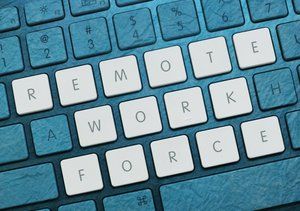The latest on all kinds of information, news, and resources that help you make working remotely better.

Remote working is becoming increasingly popular in business. It can drive down costs and improve employee happiness. But how do you make your company remote?
The desire for employees to work remotely is on the rise. Workers value the flexibility, and employers can save thousands on operational costs. If your employees all work from home, that means no office space to rent, no bills for food, no more electric bills to power your office equipment. It can also open you up to new avenues of online business.
Can you actually make your business remote?
Companies considering a move to remote operation need to perform an analysis of their brand and establish whether or not it is actually beneficial, or even realistic.
Considerations to make include:
- Efficiency and practicalities. How will remote working impact your ability to complete the tasks you and your workforce normally perform? Will it speed things up, slow them down or maintain similar output levels?
- Consumer satisfaction. Is an office or storefront part of your core service delivery process? If so, moving remotely may impact how your customers perceive the value of your company.
- Investment. Going remote may require investment into staff, equipment and work tools.
- Growth opportunities. Could going remote hinder your ability to grow? While it could be beneficial in some circumstances, operating a physical location within vibrant, industry-leading areas can be important to attracting investors and building relationships.
Consider your transitional strategy.
How should you go about doing this?
- Identify goals. What are your goals for going remote?
- How will you achieve those goals? Establish how you will use remote working to achieve the goals you’ve set.
- Timeframes and deadlines. Set broad deadlines for establishing your remote business. Then set firm schedules and timelines for specific steps of the transition within those deadlines.
- Announcement. Inform clients and employees of the change. Allow enough time for questions to be asked and decisions to be made. Some employees and clients may be against the shift. They must be given time either to adjust to the change or to move on from your business, allowing you to fill gaps now. This is beneficial to both them and your company.
Establish your software platforms.
Software exists to manage all facets of remote working life, covering everything already in place in your typical workplace headquarters.
- Work connectivity. Cloud-based software allows you to connect your business to any location in the world. Many applications provide helpful tools for maintaining long-distance workplace connectivity.
- Industry-specific software. Most industries have specifically tailored cloud-based software that supports remote work. You just have to do your research and find what works for your brand.
- Task management. Task management apps enable management to establish task lists, set deadlines and monitor progress for both themselves and their team.
- Time management. Time management apps exist to track everything from work logs to activity levels.
- Client and team communication. There are many apps that work well for online workplaces, enabling multiple channels of conversation that range from direct messaging to large chatrooms with hundreds of individuals. You can also use video conferencing to add that personal face-to-face touch when chatting with clients or engaging in important internal conversations and meetings.
Test your remote work structure.
Plans on paper rarely translate perfectly to real-world scenarios. Therefore, to ensure your shift in direction doesn’t lead to calamity, a trial period is recommended. During this time, partial remote work should be exercised.
Depending on your business, this will take different forms:
- If you have a large roster of clients and employees, split them up. Assign some clients and employees to continue working under the current office-based structure while others are moved to a remote work structure and practices.
- For smaller companies, instead of transitioning some individuals to the new system, make a switch to part-time remote work and monitor the difference in processes.
Any issues that come up you can then evaluate and decide to either scrap the project or revisit the planning process, assessing better avenues based on feedback and performance. For example, you may find your software choices are ineffective in practice or that clients who initially responded positively to the idea are making the transition more challenging.
If you find remote working to be a triumph, now is the time to make the full commitment.

Not the 9-to-5 grind, these flexible jobs may surprise you.
Listed by Boulder-based Flexjobs, these varied positions — which go far beyond general office work or data entry — could involve telecommuting, freelance gigs or part-time work.
Here are 15 of the most surprising flexible jobs:
- Senior Food Stylist. Responsible for styling food and kitchenware products for photo shoots.
- Music Researcher. Handles responsibilities including recording music performances, conducting in-person research in businesses, photographing locations, and completing detailed reports.
- Gameplay tester. Responsibilities include helping discover creative approaches to various game features, identifying bugs, creating & executing test cases for specified features, and communicating issues & risks.
- Medical illustrator. Develops editorial imagery required for new products.
- Senior voice recording transcriber. Transcribe 30 to 60 minute audio files into transcripts that are near verbatim, differentiation between interviewer and participants’ remarks.
- Animal behavior counselor. Handles tasks such as providing on-scene behavioral trauma documentation, conducting behavior evaluations, reviewing and editing forensic behavior reports, participating in media interviews, and other assigned duties.
- Archivist. Lead projects, convert data and work to engage audiences.
- Mammalogist. Develop survey and research projects, identify informational needs, communicate information, and assist land managers.
- Opioid program specialist. Assists with developing or revising contracts, grant applications, and/or state and federal reports.
- Investigator – Civil rights. Responsible for completing investigative and mediation activities.
- Oceanographer. Lead, analyze, interpret, portray and input technical data, prepare environmental impact statements, serve as program lead.
- Organic certification specialist. Performs technical reviews of crop, wild crop, livestock, or processor applications.
- Pig idea and policy officer and stakeholder coordinator. Manages and supports implementation initiatives and queries that arise from users.
- Role player, assessment practice. Conducts phone-based role-play exercises and rates participants at a virtual assessment center.
- Construction control representative (civil). Responsible for overseeing dam modifications and civil construction projects.
Flexjobs also maintains a list of 50 current “surprising” flexible jobs as well as a database of the 50 most surprising jobs based on 10 years of aggregated research. Here’s the full report.

When you work in an office, there are plenty of distractions that can get in the way of you doing your literal job, from noisy co-workers, to blasting music, to that “open workspace” vibe, which basically invites everyone to come talk to you at your desk every five minutes. But even if you work from home, there are distractions you have to avoid there, too, like playing with your pet floof, or toggling over to Netflix for 10 minutes or so for a “quick” break.
Here are six quick tips for drowning out the daily noise of your life and getting sh*t done faster.
- Invest In Noise-Cancelling Headphones
Sometimes the easiest way to get rid of distractions is to literally block them out. Investing in a clutch pair of headphones that block out the external noise of your life doesn’t have to bankrupt you, either; there are plenty of noise-cancelling headphones under $100 for you to consider.
- Schedule A Work-From-Home Day When Things Get Really Hectic
Working from home ensures you can actually run your day the way you want to, without dealing with unexpected meetings or co-workers who drop by “for a second” just to talk. You probably won’t be able to work from home all the time, depending on what you do, but taking that day for yourself every once in a while can definitely help you get back on track with your productivity.
- Use Your Calendar To Block Out Time On Your Schedule
Even if it’s purely for the visual aspect of it all, blocking out time on your calendar could be enough to a) keep people at work from bothering you, and b) organize your time in a way that ensures you get everything done, distraction-free.
- Map Out Exactly What You Need To Do Before You Do It
Consider taking time each evening to write down a set of notes about what you need to get done the next day. That way, you won’t have to waste time scrolling through calendars or asking your co-workers what they need from you.
- Organize Your Workspace With A Minimalist Vibe
Unless your brain only works via a series of sticky notes, try keeping your desk as minimalist as possible, allowing you to move through your workday without feeling totally overwhelmed by the clutter. Or keep it totally messy, if that’s what makes you feel better! It’s all about finding the environment that makes you feel best as you work.
- Be Honest With Friends and Co-Workers
Although it might feel awkward to tell someone to go away, everyone understands the feeling of being overwhelmed by the amount of work you need to get done, and for that reason alone, it might be best to be totally honest with your co-workers and friends about needing that distraction-free time.
Consider telling them you need an especially quiet day to get through all of the bullets on your to-do list, or opting to work during lunch to take advantage of the quiet and taking your break when everyone else comes back.
Tips to manage remote employees | Chris Smith, Knowtechie.com

Remote work and freelancing is not all guts and glory and can become quite stressful for people. While this is rarely the case, there are ways to fix these issues and improve the relationship between managers and remote employees. Let’s explore some strategies.
Optimize Your On-Boarding Process
With proper expectations in place, remote employees are equipped with the skills and knowledge they require to succeed at a job. Create goals and timelines for projects and run new remote employees through the ropes to see how well they handle it and how on time each task comes in.
Create a Unified Culture
With a unified company culture, you can immediately weed out the weeds who don’t fit into your organization and don’t believe in its mission.People are motivated to work for companies they feel are larger than themselves. Create a sense of pride and direction for each employee, regardless of their status, to motivate them to do more. Loyalty and community lead to leadership and increased collaboration.
Leverage the Right Telecommunication Tools
There are so many tools out there to keep up with remote employees and communicate in real-time. Skype is an obvious one, but Slack is another great alternative that many companies now leverage. 43% of the nation’s richest 100 companies use Slack. For companies that rely on remote crews, crew trackers and attendance management systems allow managers to keep track of employees by location and project status.
Communicate Emotion in Chats
When you can’t communicate in real time, try to keep communication light and fun. It may sound stupid, but use gifs and emojis to convey emotion to freelancers and remote workers to make them feel a part of the team. Be sure to give praise when earned through emojis and announcements on Slack.
Be Flexible, But Keep a Backbone
Finally, it’s important to set schedules and deadlines for remote workers to adhere to. But you mustn’t forget the purpose of remote work, which is the ability to complete assignments freely and on your own timeline. Offer remote workers the freedom they need to work a night shift busting out content instead on the 9-5 grind. Of course, don’t let that mean remote workers are too free to give you the work months behind because they finally got to it.